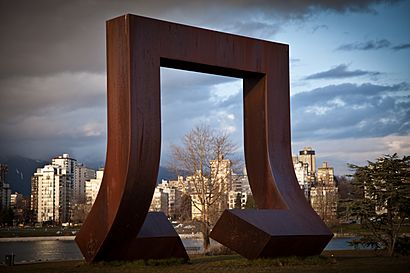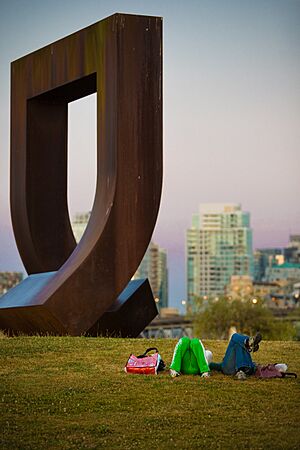Gate to the Northwest Passage facts for kids
Quick facts for kids Gate to the Northwest Passage |
|
|---|---|

The sculpture framing Vancouver's skyline in 2011
|
|
| Artist | Alan Chung Hung |
| Year | 1980 |
| Type | Sculpture |
| Medium | Corten steel |
| Dimensions | 4.6 m × 4.6 m (15 ft × 15 ft) |
| Location | Vancouver, British Columbia, Canada |
| 49°16′41″N 123°08′42″W / 49.27812°N 123.14498°W | |
| Owner | City of Vancouver |
The Gate to the Northwest Passage is a large sculpture created in 1980. It stands next to the Vancouver Maritime Museum in Vanier Park. This park is in the Kitsilano area of Vancouver, British Columbia, Canada.
The sculpture is 4.6 meters (about 15 feet) tall. It looks like a square that has been cut and twisted, much like a giant paper clip. It forms an arch that you can walk through. The artwork is made from a special kind of steel called Corten steel. This steel rusts on the outside, but this rust actually protects it from further damage.
The sculpture was put in place in 1980. It honors Captain George Vancouver's arrival in Burrard Inlet. This happened after a competition held by Parks Canada a year earlier. When it was first shown, some people didn't like it. But over time, more people have come to appreciate it. Today, the Gate to the Northwest Passage is a popular stop on walking tours around Vanier Park.
Contents
Meet the Artist: Alan Chung Hung
The Gate to the Northwest Passage was designed by Alan Chung Hung (1946–1994). He was born in Canton, China. Alan moved to Vancouver in 1969. He then studied art at the Vancouver School of Art.
Alan Chung Hung created other artworks that can be seen in Vancouver. These include a sculpture called Spring from 1981. Another one is Clouds, which he made in 1991.
Why Was the Sculpture Built?
In 1979, Parks Canada held a competition. They wanted a lasting artwork to remember Captain George Vancouver. He was the first European explorer to enter Burrard Inlet in 1792.
The rules for the competition were clear. The artwork had to be made from strong materials, not wood. It also could not be a statue of a person. Hugh Faulkner, who was a government minister at the time, helped make this project possible. The Historic Sites and Monuments Board of Canada also suggested the idea.
A group of five judges chose Gate to the Northwest Passage. This group was led by Stuart Lefeaux, a former park superintendent. The Parks Board then approved their choice. The sculpture was first planned for Stanley Park. But in 1980, it was placed in Vanier Park, next to the Vancouver Maritime Museum.
What Does the Sculpture Look Like?
The sculpture is 4.6 meters (about 15 feet) tall. It is shaped like a square that has been cut and twisted. It looks like a giant paper clip forming an arch. It is made of Corten steel. Each side of the square is 0.9 meters (about 3 feet) wide.
Corten steel is special because it rusts on its surface. This rust creates a protective layer. This layer stops the steel from rusting all the way through.
The sculpture stands on a paved area. This area measures 7.9 meters (26 feet) by 8.5 meters (28 feet). From here, you can see beautiful views of English Bay, the North Shore Mountains, and the city.
What Does the Sculpture Mean?
Experts John Steil and Aileen Stalker have written about public art in Vancouver. They think the sculpture's design might have two inspirations. One is Alan Chung Hung's background as a civil engineer. The other is the shapes of old navigation tools. These tools, like plane tables and quadrants, were used by explorers like George Vancouver.
Alan Chung Hung himself explained his goal. He said the sculpture aims to create a strong image. It should make people think about Captain George Vancouver's important work. This includes his careful maps and surveys of the North Pacific coast.
The City of Vancouver now owns the sculpture. Parks Canada was the organization that helped fund and start the project.


